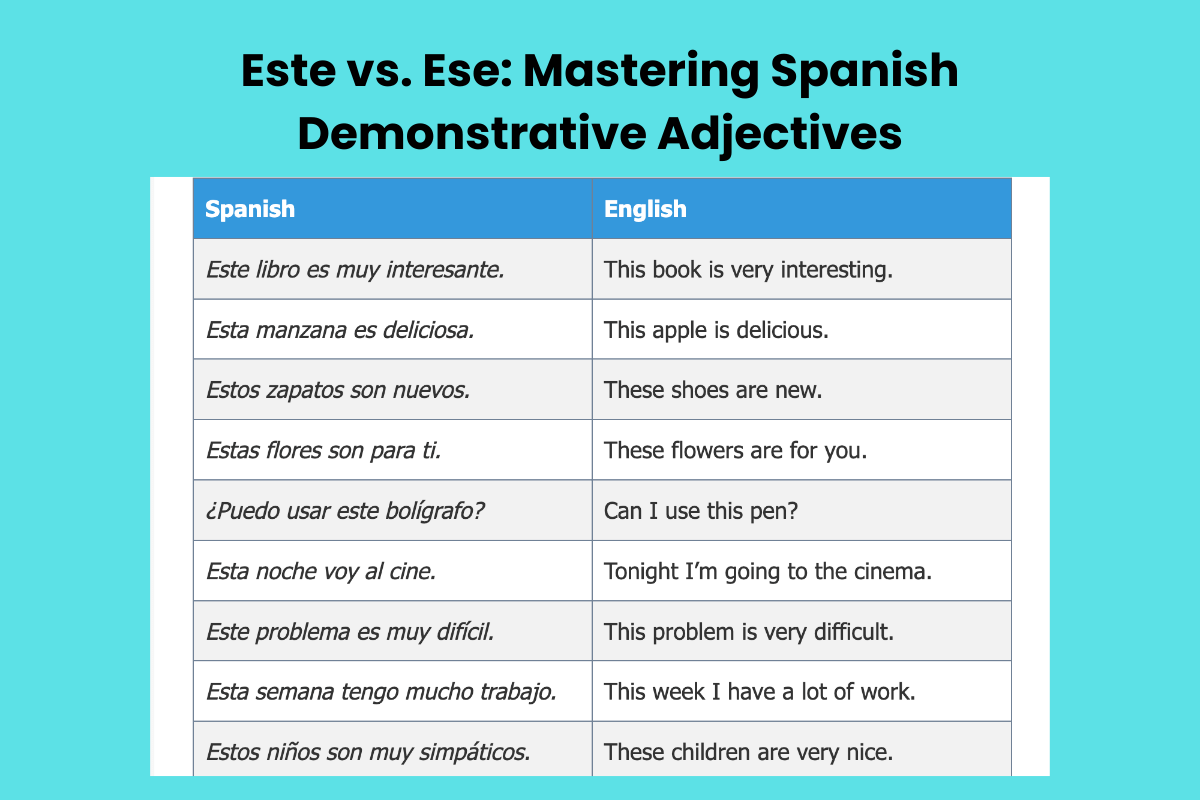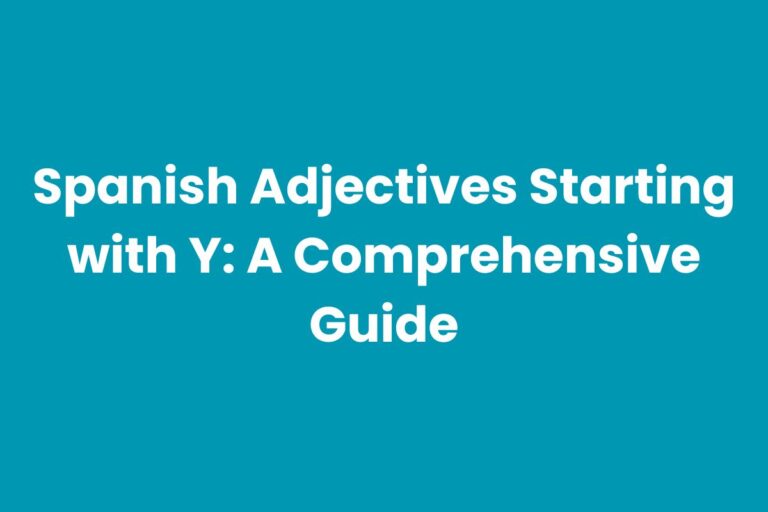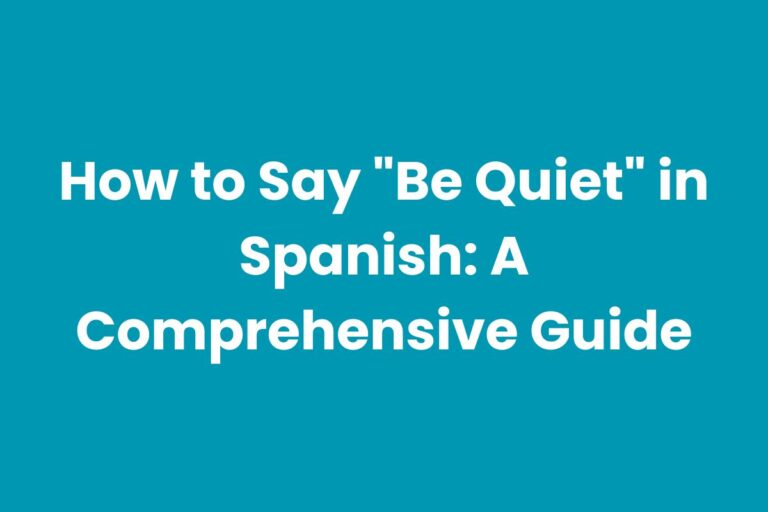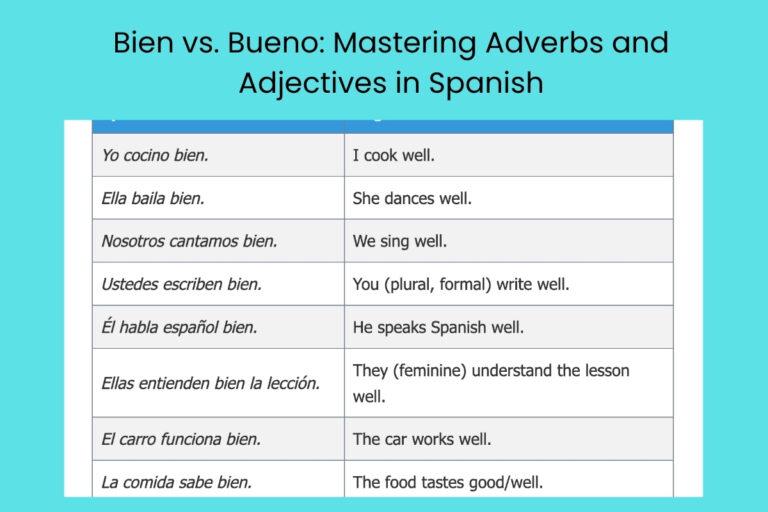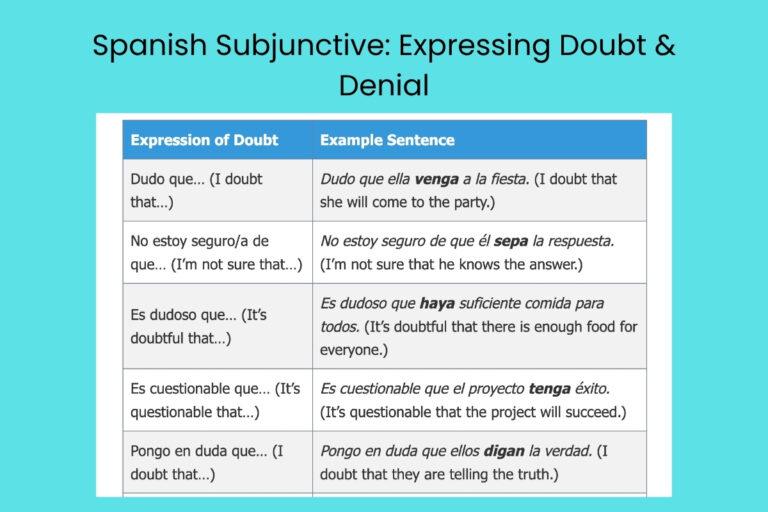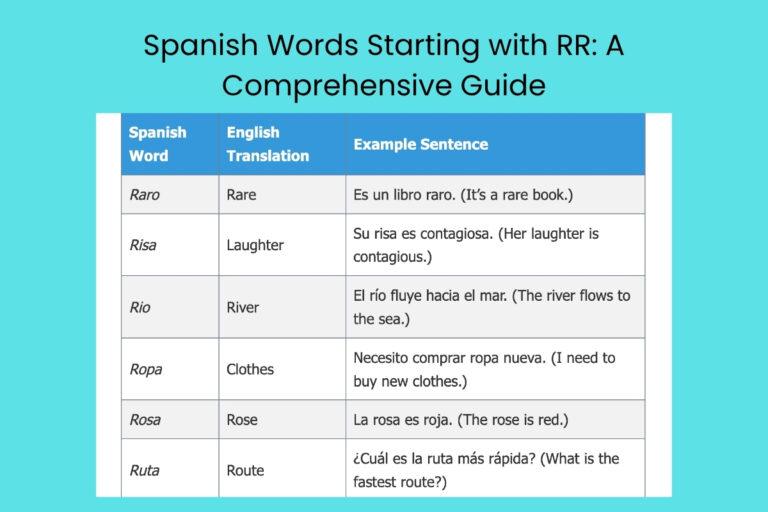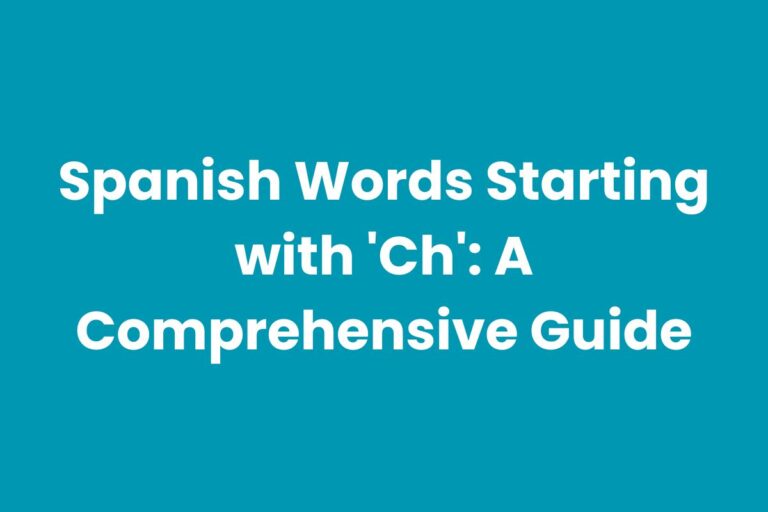Este vs. Ese: Mastering Spanish Demonstrative Adjectives
Understanding the difference between este and ese in Spanish is crucial for expressing proximity and accurately conveying your intended meaning. These demonstrative adjectives indicate the relative distance of a noun from the speaker and listener. Mastering their usage will significantly improve your fluency and comprehension in Spanish. This article provides a comprehensive guide to este and ese, including definitions, structural breakdowns, usage rules, common mistakes, and practice exercises. It is designed for Spanish learners of all levels, from beginners seeking a solid foundation to advanced students aiming to refine their understanding.
Table of Contents
- Introduction
- Definition of Este and Ese
- Structural Breakdown
- Types and Categories
- Examples of Este and Ese in Use
- Usage Rules for Este and Ese
- Common Mistakes with Este and Ese
- Practice Exercises
- Advanced Topics
- Frequently Asked Questions
- Conclusion
Definition of Este and Ese
Este and ese are Spanish demonstrative adjectives that indicate the proximity of a noun to the speaker and listener. They help to specify which item or person is being referred to, based on its location relative to the individuals in the conversation. Understanding their distinction is critical for clear and accurate communication.
Este: Definition and Usage
Este (masculine) and esta (feminine) mean “this” in English. They are used to refer to something that is close to the speaker. This proximity can be physical, temporal (time-related), or even conceptual. The plural forms are estos (masculine) and estas (feminine). Essentially, if you can almost touch it, you’d likely use este.
Ese: Definition and Usage
Ese (masculine) and esa (feminine) mean “that” in English. They refer to something that is closer to the listener or at a moderate distance from both the speaker and the listener. The plural forms are esos (masculine) and esas (feminine). Think of it as something just out of reach, but not far away.
Structural Breakdown
The structure of este and ese, along with their variations, follows a consistent pattern based on gender and number. They function as adjectives, meaning they modify nouns and must agree with those nouns in both gender and number.
Gender and Number Agreement
Like most adjectives in Spanish, este and ese must agree in gender (masculine or feminine) and number (singular or plural) with the noun they modify. This is a fundamental rule of Spanish grammar. Failure to adhere to this rule will result in grammatically incorrect sentences.
| Masculine Singular | Feminine Singular | Masculine Plural | Feminine Plural | |
|---|---|---|---|---|
| Este (This) | Este libro (This book) | Esta casa (This house) | Estos libros (These books) | Estas casas (These houses) |
| Ese (That) | Ese libro (That book) | Esa casa (That house) | Esos libros (Those books) | Esas casas (Those houses) |
The table above clearly illustrates how the forms of este and ese change to match the gender and number of the noun they describe. Note the consistent pattern: masculine singular, feminine singular, masculine plural, and feminine plural.
Types and Categories
While primarily used as demonstrative adjectives, este and ese also have pronoun and adverbial forms. Understanding these different forms is essential for comprehensive mastery.
Demonstrative Adjectives
As adjectives, este and ese modify nouns, specifying which one is being referred to based on proximity. They always precede the noun they modify and must agree in gender and number. This is their most common usage.
Demonstrative Pronouns
When used as pronouns, este and ese replace the noun entirely. In this case, they carry an accent mark to distinguish them from the adjective forms: éste, ésa, éstos, ésas. The pronoun forms also include the neutral forms esto and eso, which refer to unspecified or abstract concepts.
Demonstrative Adverbs
Spanish also has demonstrative adverbs that correspond to este and ese. These adverbs indicate location relative to the speaker and listener: aquí (here, close to the speaker), ahí (there, close to the listener or at a moderate distance), and allí (over there, far from both). While not directly related to este and ese, understanding these adverbs complements the understanding of proximity in Spanish.
Examples of Este and Ese in Use
The following examples illustrate the usage of este and ese in various contexts. Pay close attention to the gender and number agreement, as well as the relative proximity implied by each word.
Examples with Este
These examples demonstrate the use of este and its variations to indicate proximity to the speaker. Note how the form changes based on the gender and number of the noun it modifies.
| Spanish | English |
|---|---|
| Este libro es muy interesante. | This book is very interesting. |
| Esta manzana es deliciosa. | This apple is delicious. |
| Estos zapatos son nuevos. | These shoes are new. |
| Estas flores son para ti. | These flowers are for you. |
| ¿Puedo usar este bolígrafo? | Can I use this pen? |
| Esta noche voy al cine. | Tonight I’m going to the cinema. |
| Este problema es muy difícil. | This problem is very difficult. |
| Esta semana tengo mucho trabajo. | This week I have a lot of work. |
| Estos niños son muy simpáticos. | These children are very nice. |
| Estas galletas están muy ricas. | These cookies are very tasty. |
| Este es mi coche. | This is my car. |
| Esta es mi casa. | This is my house. |
| Estos son mis amigos. | These are my friends. |
| Estas son mis hermanas. | These are my sisters. |
| Este día es muy especial. | This day is very special. |
| Esta tarde voy a estudiar. | This afternoon I’m going to study. |
| Estos ejercicios son fáciles. | These exercises are easy. |
| Estas vacaciones voy a viajar. | This vacation I’m going to travel. |
| Este año voy a aprender español. | This year I’m going to learn Spanish. |
| Esta canción es muy popular. | This song is very popular. |
This table provides a variety of sentences using este and its forms, demonstrating how they are used to refer to things that are physically or temporally close to the speaker.
Examples with Ese
These examples showcase the use of ese and its variations to indicate proximity to the listener or a moderate distance from both the speaker and the listener. Again, note the importance of gender and number agreement.
| Spanish | English |
|---|---|
| Ese libro es tuyo. | That book is yours. |
| Esa casa es muy grande. | That house is very big. |
| Esos coches son muy caros. | Those cars are very expensive. |
| Esas flores son hermosas. | Those flowers are beautiful. |
| ¿Conoces a ese hombre? | Do you know that man? |
| Esa noche fue inolvidable. | That night was unforgettable. |
| Ese problema es más fácil. | That problem is easier. |
| Esa semana estuve de vacaciones. | That week I was on vacation. |
| Esos niños son muy ruidosos. | Those children are very noisy. |
| Esas galletas parecen deliciosas. | Those cookies look delicious. |
| Ese es tu problema. | That is your problem. |
| Esa es tu oportunidad. | That is your opportunity. |
| Esos son tus amigos? | Are those your friends? |
| Esas son tus llaves. | Those are your keys. |
| Ese día fue muy largo. | That day was very long. |
| Esa tarde llovió mucho. | That afternoon it rained a lot. |
| Esos ejercicios son complicados. | Those exercises are complicated. |
| Esas montañas son muy altas. | Those mountains are very high. |
| Ese año fue muy difícil. | That year was very difficult. |
| Esa canción me gusta mucho. | I like that song a lot. |
| Ese coche de allí es suyo. | That car over there is theirs. |
| Esa chica es muy amable. | That girl is very kind. |
| Esos chicos están jugando al fútbol. | Those boys are playing soccer. |
| Esas señoras están hablando mucho. | Those ladies are talking a lot. |
This table provides a wide array of examples using ese and its corresponding forms, demonstrating their use to refer to things at a moderate distance or closer to the listener.
Examples of Esto, Eso
The neutral demonstrative pronouns esto and eso are used to refer to abstract concepts, situations, or unspecified things. They do not have gender or number.
| Spanish | English |
|---|---|
| Esto es muy importante. | This is very important. |
| Eso no es verdad. | That is not true. |
| No entiendo esto. | I don’t understand this. |
| ¿Qué es eso? | What is that? |
| Esto me parece bien. | This seems good to me. |
| Eso es lo que quiero. | That’s what I want. |
| Esto es un secreto. | This is a secret. |
| Eso es una mentira. | That is a lie. |
| Con esto basta. | This is enough. |
| Eso es todo. | That’s all. |
This table illustrates the use of esto and eso, highlighting their role in referring to general ideas or situations without specifying gender or number.
Usage Rules for Este and Ese
The proper use of este and ese hinges on understanding the rules governing proximity, context, and abstract references. Mastering these rules will significantly improve your accuracy and fluency.
Proximity Rule
The fundamental rule is that este refers to things closer to the speaker, while ese refers to things closer to the listener or at a moderate distance from both. This proximity can be physical, temporal, or conceptual. If something is within your reach, you’d generally use este. If it’s closer to the person you are speaking to, or further away from both of you, you’d use ese.
Conversational Context
The context of the conversation can also influence the choice between este and ese. For instance, when referring back to something previously mentioned by the speaker, este is often used. Conversely, when referring back to something mentioned by the listener, ese is often used. This helps maintain clarity and coherence in the conversation.
Referring to Abstract Concepts
When referring to abstract ideas or situations, the neutral forms esto and eso are used. Esto generally refers to something that is currently being discussed or is about to be discussed, while eso refers to something that was previously mentioned or is generally known. These forms are invaluable for discussing complex or abstract topics.
Common Mistakes with Este and Ese
Several common errors can occur when using este and ese. Being aware of these mistakes and understanding how to avoid them is crucial for improving accuracy.
Gender Agreement Errors
One of the most frequent mistakes is failing to correctly match the gender and number of the demonstrative adjective with the noun it modifies. For example, saying “Este casa” instead of “Esta casa” is a common error. Always double-check the gender and number of the noun before choosing the correct form of este or ese.
Proximity Misunderstandings
Another common mistake is confusing the proximity implied by este and ese. Using este when referring to something closer to the listener, or ese when referring to something right next to the speaker, can lead to misunderstandings. Pay close attention to the relative positions of the speaker, listener, and the object being referred to.
Pronoun-Adjective Confusion
Forgetting the accent mark on the pronoun forms (éste, ésa, etc.) is another frequent error. Remember that the accent mark distinguishes the pronoun from the adjective. Using the adjective form when a pronoun is required, or vice versa, can change the meaning of the sentence.
Practice Exercises
These exercises will help you solidify your understanding of este and ese. Work through them carefully, paying attention to the context and the rules you’ve learned.
Exercise 1: Fill in the Blanks
Fill in the blanks with the correct form of este or ese.
| Question | Answer |
|---|---|
| ¿Te gusta _______ libro? (that) | Ese |
| _______ casa es mía. (This) | Esta |
| ¿Cuánto cuestan _______ zapatos? (these) | Estos |
| _______ flores son para ti. (Those) | Esas |
| _______ día es muy importante. (This) | Este |
| No entiendo _______ problema. (that) | Ese |
| _______ semana tengo mucho trabajo. (This) | Esta |
| _______ niños son muy educados. (These) | Estos |
| ¿Quién es _______ hombre? (that) | Ese |
| _______ es mi oportunidad. (This) | Esta |
Exercise 2: Translate the Sentences
Translate the following sentences into Spanish using este or ese.
| English | Spanish |
|---|---|
| This car is very fast. | Este coche es muy rápido. |
| That woman is my mother. | Esa mujer es mi madre. |
| These books are very interesting. | Estos libros son muy interesantes. |
| Those houses are very expensive. | Esas casas son muy caras. |
| This exercise is very easy. | Este ejercicio es muy fácil. |
| That movie was very good. | Esa película fue muy buena. |
| These questions are difficult. | Estas preguntas son difíciles. |
| Those answers are correct. | Esas respuestas son correctas. |
| This is my friend. | Éste es mi amigo. |
| That is my dream. | Ése es mi sueño. |
Exercise 3: Error Correction
Identify and correct the errors in the following sentences.
| Incorrect | Correct |
|---|---|
| Este casa es bonita. | Esta casa es bonita. |
| Esas libro es interesante. | Ese libro es interesante. |
| Esta coches son caros. | Estos coches son caros. |
| Ese flores son hermosas. | Esas flores son hermosas. |
| Estos problema es difícil. | Este problema es difícil. |
| Esa semana tengo vacaciones. | Esta semana tengo vacaciones OR Esa semana tuve vacaciones. |
| Estos niños es simpático. | Estos niños son simpáticos. |
| Ese galletas están ricas. | Esas galletas están ricas. |
| Esta es mi hermanos. | Estos son mis hermanos. |
| Ese es mi hermana. | Ésta es mi hermana. |
Advanced Topics
For advanced learners, understanding regional variations and formal vs. informal usage can further refine your mastery of este and ese.
Regional Variations
While the basic rules of este and ese remain consistent across Spanish-speaking regions, subtle variations in usage may exist. For example, in some regions, the distinction between ese and aquel (that over there, far away) may be less pronounced. Exposure to different dialects will help you become more attuned to these nuances.
Formal vs. Informal Usage
In formal contexts, it’s important to adhere strictly to the proximity rules. In informal settings, however, the usage may be more relaxed. For instance, speakers might use ese even when referring to something closer to themselves, especially when emphasizing a point or expressing surprise. Understanding these subtle differences requires experience and careful observation of native speakers.
Frequently Asked Questions
Here are some frequently asked questions about este and ese.
- What is the difference between este and ese?
Este refers to something close to the speaker, while ese refers to something close to the listener or at a moderate distance from both.
- How do I know which form of este or ese to use?
The form must agree in gender and number with the noun it modifies. For example, use esta for feminine singular nouns, estos for masculine plural nouns, etc.
- When should I use esto or eso?
Use esto and eso for abstract concepts or situations, without specifying gender or number. Esto refers to something currently being discussed, while eso refers to something previously mentioned.
- What is the difference between the adjective and pronoun forms of este and ese?
The pronoun forms (éste, ésa, etc.) have an accent mark and replace the noun entirely. The adjective forms (este, esa, etc.) modify the noun.
- Can I use este to refer to something in the past?
Yes, este can be used to refer to a recent past, or the present day. For example, “Esta mañana fui al mercado” (This morning I went to the market).
- Is it wrong to use ese when something is close to me?
While generally este would be more appropriate, in informal contexts, ese can be used for emphasis or surprise, even if the object is near the speaker.
- How do I avoid making mistakes with gender agreement?
Always pay close attention to the gender of the noun you are modifying. If you are unsure, consult a dictionary or grammar resource.
- Are there any regional variations in the usage of este and ese?
Yes, subtle variations may exist in different Spanish-speaking regions. Exposure to different dialects can help you become aware of these nuances.
- What are the demonstrative adverbs related to este and ese?
The demonstrative adverbs are aquí (here), ahí (there), and allí (over there), indicating location relative to the speaker and listener.
- How can I practice using este and ese?
Practice by completing exercises, translating sentences, and paying attention to how native speakers use these words in conversation and writing.
Conclusion
Mastering the distinction between este and ese is a fundamental step towards achieving fluency in Spanish. These demonstrative adjectives are essential for accurately conveying proximity and specifying which item or person is being referred to. By understanding the definitions, structural rules, and usage guidelines outlined in this article, you can significantly improve your communication skills. Remember to practice regularly, pay attention to context, and be mindful of common mistakes. With consistent effort, you will confidently and correctly use este and ese in your Spanish conversations and writing.

